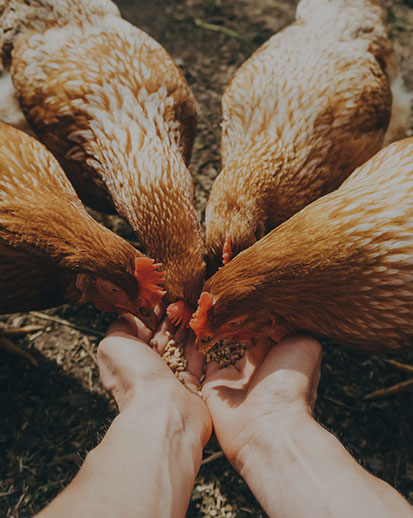Demand for animal protein continues to rise as the world’s population grows. The World Resources Institute predicts that this demand will reach 445 million tons of animal protein per year by 2050, to meet the needs of a projected population of 9.1 billion. According to the UN Food and Agriculture Organization (FAO), this means approximately 70% growth compared to today.
This growth in animal production places tremendous pressure on the world’s natural resources. The animal protein sector, which currently accounts for 14.5% of human-derived greenhouse gas (GHG) emissions globally, must become more efficient, use less land, and reduce its environmental footprint if it is to play its role in achieving net zero GHG emissions by 2050 while meeting the animal protein requirements of a growing global population.
At the same time, it is essential to keep a tight control over production costs so as to ensure that producers can operate at a profit while animal protein remains affordable. Feed costs reached an all-time high in 2022, and these price increases were compounded by growing pressures on harvests caused by the impact of climate change. In view of the fact that feed costs constitute some 60% to 70% of total animal production, livestock farmers are finding it increasingly challenging to maintain a balance between the demands of cost efficiency and the requirements for sustainable farming.
Feed enzymes are an established and evolving technology that offers a measurable means to achieve a balance between affordable and sustainable animal protein production. These feed additives improve feed ingredient digestibility, thereby substantially reducing the amount of feed needed to meet the world’s growing demand for animal protein. Feed enzymes also enable the greater use of alternative, local feed ingredients and by-products, thereby reducing our reliance on soy and other major crops.
The dilemma of rising feed costs
Recent imbalances in the supply and demand of commodities essential for livestock production have driven up the prices of corn, wheat and soybean, which are the main constituents of livestock diets. Poor harvests, as well as strong demand from the animal production sector, have reduced the available level of stocks of grain raw materials in the past two to three years, while demand has remained very high. Market prices for soy, corn and wheat more than doubled in consequence between January 2021 and March 2022. This already accelerating trend was exacerbated by Russia’s invasion of Ukraine in February of 2022, which had the effect of driving up raw material prices to levels not seen in the past 10 years.
Since March 2022, prices of grains and oils have remained at an unprecedentedly high level. Recent global harvests of soy, corn and wheat have disappointed expectations, with the notable exception of soy production in Brazil, keeping the stock-to-use ratio (i.e., the balance between supply and demand) very low. Thus, it is broadly expected that prices will stay on a ‘high plateau’ throughout 2023 and beyond. Furthermore, the quality and availability of grains will remain a challenge.
The current pressures on the production of feed raw materials have also led the animal production industry to adapt the composition of animal diets to deliver essential levels of energy and efficiency, using more alternative raw materials and/or by-products (e.g., dried distillers’ grains with solubles, sunflower, canola, barley, sorghum, and meat and bone meal). While the use of alternative raw materials and/or by-products is desirable from a cost perspective, it also creates certain nutritional challenges that need to be addressed.
Another key feed ingredient is rock phosphate – a finite resource, and essential for animal health. Rock phosphate experienced a more than 50% price increase during 2022, and may be subject to further sharp increases over the next five years, caused by the combination of high demand and low availability.
All the above-mentioned factors are putting the animal production industry under severe pressure to manage its feed costs and protect its profitability.
Feed enzymes offer a potential solution here. They help improve animal performance when used in combination with existing diets. Feed enzymes such as carbohydrases and proteases can facilitate body weight gain of between 1% and 7%, while at the same time improving feed conversion ratio (FCR, a measure of an animal’s efficiency to convert feed into increased body mass) by 1%. In summary, a farmer needs less feed for the same output, which reduces not only overall feed costs but also the environmental footprint.
Feed enzymes for feed optimization
There are various categories of feed enzymes designed to reduce feed costs. Phytase, for example, helps optimize phosphorous nutrition by degrading phytic acid. Phytic acid is the principal form of storage for phosphorus in plant seeds. Optimizing its degradation by the use of feed enzymes means that less rock phosphate needs to be added to animal diets. Carbohydrases help optimize energy release from raw materials of plant origin and increase the availability of this energy to the metabolism. Protein is an expensive feed nutrient, and feed protease can improve its digestibility. Feed enzymes also play a critical role in degrading anti-nutritional factors such as phytic acid, trypsin (a digestive enzyme that breaks down proteins in the small intestine) inhibitors and non-starch polysaccharides.
Our feed optimization portfolio is unique in the feed enzymes market, offering the broadest range of feed enzyme solutions across species, as well as the latest cutting-edge technologies. In 2022, we launched our new generation phytase, HiPhorius®, taking the parameters of available phosphorus release to new levels. This followed our 2021 release of ProAct 360™, the first and only second-generation feed protease, with improved speed and efficacy. Finally, we also offer the broadest range of carbohydrase products, with RONOZYME®WX, RONOZYMET® MultiGrain, RONOZYME® HiStarch and RONOZYME® VP. Some of these products have unique enzymatic activities that can extract nutrients from every feed raw material of plant origin, helping nutritionists to optimize the inclusion of these materials in the feed.
This cutting-edge range of enzymatic solutions can be combined to leverage the individual features of each product, delivering very attractive cost savings and a return on investment ranging from 1:3 to 1:15, depending on dietary composition and the enzyme technology used.
Stronger together with Pecuario CMI
CMI is a family-owned company that has been generating job opportunities and promoting economic development across Central America since 1920. Operating in 15 countries today, CMI offers high-quality products and services through its two Business Groups, Foods and Capital. The CMI business portfolio is highly varied, and includes wheat flour mills; pasta, cracker and cookie manufacturing; poultry and swine production, processed meats and various types of sausages; nutritional animal production and pet foods; and restaurants featuring the Pollo Campero brand.

“The use of DSM enzymes in our operations allowed us to significantly reduce feed costs without compromising animal performance. It also contributed to reducing the environmental footprint, contributing to our sustainability goals with a positive impact on individuals, families and communities.”
Sergio Sevilla
Do you know?
Despite its huge potential for saving feed costs, what is the current penetration rate of protease technology in monogastric species (i.e., animals with a single-compartmented stomach, such as poultry and pigs)?
Our impact
Our transformational enzymatic solutions are the product of an industry-leading partnership with Novozymes, the world leader in biosolutions. For more than two decades, the DSM-Novozymes Alliance has potentiated our respective strengths in animal nutrition and enzymatic technology. We have united our unique capabilities by means of a common mindset, a cutting-edge science platform, and effective ways of collaboration, to create an innovation powerhouse for animal nutrition.
Through the DSM-Novozymes Alliance, we offer customers our combined expertise in enzyme development and animal nutrition and health, allowing them to succeed in their business by raising healthy and high-performing animals in a sustainable way.
Overall, we estimate that the use of feed enzymes technology by the animal production industry has the potential to deliver annual cost savings in excess of €5 billion, across monogastric species (i.e., animals with a single-compartmented stomach, such as poultry and pigs). Moreover, our feed enzymes also support more sustainable animal production by facilitating more efficient use of natural resources while reducing emissions of nitrogen, phosphorous and CO2eq and improving the welfare of farm animals by increasing the bioavailability of the full nutritional and caloric content of reformulated diets.
RONOZYME® HiPhos and HiPhorius® phytase technologies enable the reduction or even elimination of the use of rock phosphate in animal diets, turning the phytate naturally present in feed raw materials of plant origin into available phosphorous and myo-inositol, thus reducing feed costs and at the same time reducing phosphorus loss into the environment.
RONOZYME® ProAct & ProAct 360™ protease technologies optimize the digestibility of the available protein in the feed, permitting lower inclusion levels of soy products, reducing feed costs and reducing nitrogen losses into the environment.
Our carbohydrase solutions (RONOZYME® WX, RONOZYME® MultiGrain, RONOZYME® HiStarch and RONOZYME® VP) enable optimization of the energy available in the feed, allowing the inclusion of lower proportions of grain, oils and fats and more use of local alternative raw materials. Incorporating these carbohydrases in the diet reduces feed costs while at the same time delivering an improved environmental footprint.
A recent feed formulation exercise by DSM revealed that further feed cost reductions are also possible. For example, the use of a combination of RONOZYME® ProAct, RONOZYME® HiPhos (2000 FYT/kg) and RONOZYME® Multigrain generated a cost reduction of USD 32 per metric ton of feed compared with a formulation based on 1,000 phytase units (FYT) per kilogram of RONOZYME® HiPhos with only a mineral matrix applied.
How we support the SDGs
Our innovative enzyme solutions for feed optimization enable more nutritional value to be obtained from the diet while supporting animal health and well-being and reducing the environmental impact of livestock farming. They thus contribute to the achievement of four of the SDGs.
2
2 – End hunger, achieve food security and improved nutrition and promote sustainable agriculture
Our feed optimization enzyme solutions enable the animal production industry to make more efficient use of natural resources by unlocking the nutrient potential of feed raw material. They support the sustainable production of valuable animal protein by permitting reduced reliance on crops such as soy and corn, as well as greater use of alternative, local feed ingredients and by-products.
3
3 – Ensure healthy lives and promote well-being for all at all ages
By enabling the production of sustainable and affordable protein from healthy animals, our feed optimization enzyme solutions contribute to the availability of healthy diets that promote well-being.
12
12 – Ensure sustainable consumption and production patterns
Our feed optimization enzyme solutions encourage sustainable consumption and production patterns by reducing reliance on crops such as soy and corn for animal diets and facilitating the increased use of alternative, local feed ingredients and by-products.
13
13 – Take urgent action to combat climate change and its impacts
Our feed optimization enzyme solutions help reduce emissions of nitrogen, phosphorous and CO2eq emissions into the environment by enabling the use of lower-protein diets and improving the digestibility of protein, as well as by reducing reliance on finite reserves of mineral phosphates.




